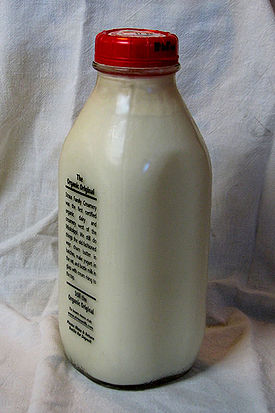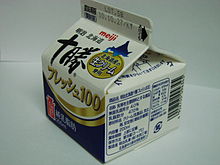- Cream
-
Cream is a dairy product that is composed of the higher-butterfat layer skimmed from the top of milk before homogenization. In un-homogenized milk, over time, the lighter fat rises to the top. In the industrial production of cream this process is accelerated by using centrifuges called "separators". In many countries, cream is sold in several grades depending on the total butterfat content. Cream can be dried to a powder for shipment to distant markets.
Cream skimmed from milk may be called "sweet cream" to distinguish it from whey cream skimmed from whey, a by-product of cheese-making. Whey cream has a lower fat content and tastes more salty, tangy and "cheesy".[1]
Cream produced by cattle (particularly Jersey cattle) grazing on natural pasture often contains some natural carotenoid pigments derived from the plants they eat; this gives the cream a slight yellow tone, hence the name of the yellowish-white color, cream. Cream from goat's milk, or from cows fed indoors on grain or grain-based pellets, is white.
Contents
Types
Different grades of cream are distinguished by their fat content, whether they have been heat-treated, whipped, and so on. In many jurisdictions there are regulations for each type.
United States
In the United States, cream is usually sold as:
- Half and half (10.5–18% fat)
- Light, coffee, or table cream (18–30% fat)
- Medium cream (25% fat)
- Whipping or light Whipping cream (30–36% fat)
- Heavy Whipping cream (36% or more)
- Extra-heavy, double, or manufacturer's cream (38–40% or more).
Not all grades are defined by all jurisdictions, and the exact fat content ranges vary. The above figures are based on the Code of Federal Regulations, Title 21, Part 131[2][3] and a small sample[which?] of state regulations.
Australia
In Australia, levels of fat in cream are not regulated, therefore labels are only under the control of the manufacturers. A general guideline is as follows:
Extra light (or 'lite'): 12–12.5% fat.
Light (or 'lite'): 18–20% fat.
Pure cream: 35–56% fat, without artificial thickeners.
Thickened cream: 35–36.5% fat, with added gelatine and/or other thickeners to give the cream a creamier texture, also possibly with stabilisers to aid the consistency of whipped cream (this would be the cream to use for whipped cream, not necessarily for cooking)
Single cream: Recipes calling for 'single cream' are referring to pure or thickened cream with about 35% fat.
Double cream: 48–60% fat.[4]
United Kingdom
In the United Kingdom, the types of cream are legally defined[5] as follows:
Name Minimum
milk fatAdditional definition Main uses Clotted cream 55% is heat treated Served as it is. A traditional part of a Cream tea. Extra-Thick Double cream 48% is heat treated then quickly cooled Thickest available fresh cream, spooned onto pies, puddings, and desserts (cannot be poured due to its consistency) Double cream 48% Whips the easiest and thickest for puddings and desserts, can be piped Whipping cream 35% Whips well but lighter, can be piped Whipped cream 35% has been whipped Decorations on cakes, topping for ice cream, strawberries and so on. Sterilized cream 23% is sterilized Cream or single cream 18% is not sterilized Poured over puddings, used in sauces Sterilized half cream 12% is sterilized Half cream 12% is not sterilized Uncommon, some cocktails Canada
Canadian cream definitions are similar to those used in the United States, except for that of "light cream." In Canada, "light cream" is low-fat cream, with 5% or 6% fat. Another form of cream available in Canada is "cereal cream", which is approximately mid-way between 5% cream and coffee cream in fat content.
Japan
In Japan, cream sold in supermarkets is usually between 35% and 48% butterfat.
Processing and additives
Cream may have thickening agents and stabilisers added. Thickeners include sodium alginate, carrageenan, gelatine, sodium bicarbonate, tetrasodium pyrophosphate, and alginic acid[6]:296[7].
Other processing may be carried out. For example, cream has a tendency to produce oily globules (called "feathering") when added to coffee. The stability of the cream may be increased by increasing the non-fat solids content, which can be done by partial demineralisation and addition of sodium caseinate, although this is expensive.[6]:297
Other cream products
Butter is made by churning cream to separate the butterfat and buttermilk. This can be done by hand or by machine.
Whipped cream is made by whisking or mixing air into cream with more than 30% fat, to turn the liquid cream into a soft solid. Nitrous oxide may also be used to make whipped cream.
Sour cream, common in many countries including the U.S. and Australia, is cream (12 to 16% or more milk fat) that has been subjected to a bacterial culture that produces lactic acid (0.5%+), which sours and thickens it.
Crème fraîche (28% milk fat) is slightly soured with bacterial culture, but not as sour or as thick as sour cream. Mexican crema (or cream espesa) is similar to crème fraîche.
Smetana is a heavy cream product (35-40% milk fat) Central and Eastern European sweet or sour cream.
Rjome or rømme is Norwegian sour cream containing 35% milk fat, similar to Icelandic rjómi.
Clotted cream, common in the United Kingdom, is cream that has been slowly heated to dry and thicken it, producing a very high-fat (55%) product. This is similar to Indian malai.
Ingredient
Cream is used as an ingredient in many foods, including ice cream, many sauces, soups, stews, puddings, and some custard bases, and is also used for cakes. Irish cream is an alcoholic liqueur which blends cream with whiskey, and often honey, wine, or coffee. Cream is also used in curries such as masala dishes.
Cream (usually light/single cream or half and half) is often added to coffee.
For cooking purposes, both single and double cream can be used in cooking, although the former can separate when heated, usually if there is a high acid content. Most UK chefs always use double cream or full-fat crème fraîche when cream is added to a hot sauce, to prevent any problem with it separating or "splitting". In sweet and savoury custards such as those found in flan fillings, crème brûlées and crème caramels, both types of cream are called for in different recipes depending on how rich a result is called for. It is useful to note that double cream can also be thinned down with water to make an approximation of single cream if necessary.
Other items called "cream"
Many non-edible substances are called creams due merely to their consistency: shoe cream is runny, unlike waxy shoe polish; face cream is a cosmetic. There is generally no restriction on describing non-edible products as creams.
Regulations in many jurisdictions restrict the use of the word cream for foods. Words such as creme, kreme, creame, or whipped topping are often used for products which cannot legally be called cream. In some cases foods can be described as cream although they do not contain predominantly milk fats; for example in Britain "ice cream" does not have to be a dairy product (although it must be labelled "contains non-milk fat"), and salad cream is the customary name for a condiment that has been produced since the 1920s[8] and need contain no cream.
See also
- Artificial cream
- Condensed milk
- Cool Whip, a brand of imitation whipped cream.
- Creamer
- Crème fraîche
- Kaymak, which is similar to clotted cream
- Sour cream
- Ice cream
- Larousse gastronomique
- Malai
- Mock cream
- Healing cream
- Whipped-cream charger, describes how nitrous oxide whips cream
References
- ^ Article on sweet cream, whey cream, and the butters they produce
- ^ FDA > CDRH > CFR Title 21 Database Search
- ^ 2005 CFR Title 21, Volume 2
- ^ http://www.choice.com.au/viewArticle.aspx?id=105898&catId=100286&tid=100008&p=6&title=Cream+and+sour+cream
- ^ Food Labelling Regulations 1998
- ^ a b Dairy Fats and Related Products, edited by Adnan Tamime. This book has a great deal of technical information on cream and other dairy fat products. Extracts available on Google books [1]
- ^ Carrageenan
- ^ UK Ministry of food orders, 1945
Categories:- Dairy products
- Condiments
Wikimedia Foundation. 2010.




